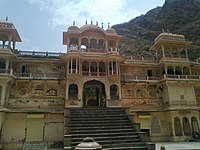Galtaji
This article needs additional citations for verification. (August 2012) |


Galtaji is an ancient Hindu pilgrimage about 10 km away from Jaipur, in the Indian state of Rajasthan. The site consists of a series of temples built into a narrow crevice in the ring of hills that surrounds Jaipur. A natural spring emerges high on the hill and flows downward, filling a series of sacred kunds (water tanks) in which pilgrims bathe. Visitors and pilgrims can ascend the crevasse, continuing past the highest water pool to a hilltop temple from there are views of Jaipur and its fortifications spreads out across the valley floor. It is believed that a Saint named Galav lived here, practiced meditation, and did penance (tapasya).[1]
Shri Galta Peeth ( Shri Galta Ji or Galav Ashram)[]
(A Registered Sole Trust Established in 1503 A.D.)

Built within a mountain pass in the Aravalli Hills 10 km. east of Jaipur,[2] Since the early 15th century Galtaji has been a retreat for Hindu ascetics belonging to the Vaishnava Ramanuja sect.[1] It is said to have been in the occupation of yogis for a long time; Payohari Krishnadas, a Ramanandi sadhu, i.e. a follower of the Ramanandi Sampradaya) came to Galta in the early 15th century and, by his yogic powers, drove away other yogis from the place.[3] Galta was northern India's first Vaishnava Ramanuja Peeth and became the one of the most important centres of the Ramanuja sect. The temple features a number of pavilions with rounded roofs, carved pillars and painted walls. The complex is set around a natural spring and waterfalls that create 7 Holy Ponds.[4]
Monkeys[]

The temple complex of Sita Ram ji temple is colloquially known as (Galwar Bagh) in travel literature, due to the large number of monkeys who live in here. These rhesus macaques were featured in National Geographic Channel's Rebel Monkeys series and "Thar Desert - Sacred sand" episode of the television series.
The Sun Temple[]
There is a small temple on the top of the hill dedicated to the Sun God. It is known as Surya Mandir.[6]
Water tanks[]
The temple is known for its natural springs, the water from which accumulates in tanks (kunds). There are seven tanks, the holiest being the Galta Kund, which never goes dry. It is considered auspicious to bathe in the waters of Galtaji, especially on Makar Sankranti, and thousands come to bathe every year.[7]

References[]
- ^ a b Vibhuti Sachdev; Giles Henry Rupert Tillotson (2002). Building Jaipur: The Making of an Indian City. Reaktion Books. pp. 39–. ISBN 978-1-86189-137-2. Retrieved 29 August 2013.
- ^ Dr. Daljeet; P. C. Jain (Prof.) (2002). Monuments Of India. Aravali Books International Pvt. Limited. p. 161. ISBN 978-81-86880-76-0.
- ^ Gupta, Dr R.K; Bakshi, Dr S.R. Rajsthan through the ages - Vol 4. Jaipur rulers and administrators. Sarup & sons. p. 118. ISBN 978-81-7625-841-8.
- ^ Ann Grodzins Gold (1990). Fruitful Journeys: The Ways of Rajasthani Pilgrims. University of California Press. pp. 278–. ISBN 978-0-520-06959-6. Retrieved 29 August 2013.
- ^ Dobson, Jim. "48 Hours In Jaipur, India: How To Experience The Spectacular Pink City In Style". Forbes. Retrieved 18 December 2019.
- ^ "Jaipur Tourism: Places to Visit, Sightseeing, Trip to Jaipur- Rajasthan Tourism". www.tourism.rajasthan.gov.in. Retrieved 18 December 2019.
- ^ Dobson, Jim. "48 Hours In Jaipur, India: How To Experience The Spectacular Pink City In Style". Forbes. Retrieved 18 December 2019.
External links[]
![]() Media related to Galtaji at Wikimedia Commons
Media related to Galtaji at Wikimedia Commons
- Hindu temples in Rajasthan
- Hindu pilgrimage sites in India
- Tourist attractions in Jaipur
- Springs of India
- Temple tanks in India
- Hindu temples in Jaipur
- Landforms of Rajasthan
